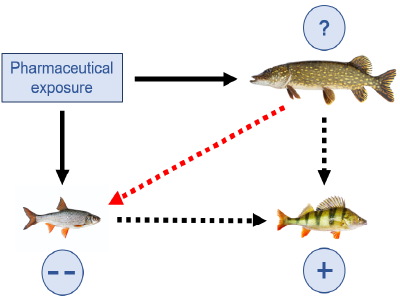
Evaluating the impacts of pharmaceutical pollution in aquatic ecosystems, from individuals to animal communities
Clean water and healthy ecosystems are central to sustainable human and animal populations. Yet, in the last decade, it has been discovered that most of our major rivers, lakes and seas are now contaminated by a wide variety of pharmaceutical pollutants (e.g. medications like antidepressants and painkillers). Most of these pollutants reach the environment via our wastewater. Of particular concern is the impact that these drugs may have on wildlife. This is because pharmaceuticals are specifically designed to have biological effects at low concentrations, and they target receptors that are also found in other animals. Indeed, pharmaceutical pollutants have now been detected in the tissues of aquatic wildlife (from insects to whales), and have been shown to change animal physiology and behaviour. However, we still know very little about how these contaminants affect animals, and nearly nothing about how these effects scale up to impact animal populations and communities. It is precisely this lack of understanding about the broader environmental impacts of pharmaceuticals that severly hampers our ability take informed action regarding pharmaceutical emissions.
My MSCA funded project ‘AquaDrugs’ will address this critical knowledge gap by harnessing new developments in underwater animal tracking (i.e. acoustic telemetery), computer automation, and targeted exposure devices (see below). Specifically, the project involves a series of integrated experiments that will connect the impacts of pharmaceutical contaminants across biological scales, from individuals, to animal groups, to multi-species communities. In the laboratory, I will determine how pharmaceuticals, both in isolation and in mixtures, impact several ecologically important behaviours that are directly linked to health, reproduction and survival in animals. Using natural field experiments, I will assess how pharmaceutical-induced behavioural changes at the individual and group levels impact multi-species interactions and aquatic communities. By connecting findings in the laboratory with observations in nature, AquaDrugs will provide new insights into the predictive power of laboratory-based behavioural studies for making contaminant risk decisions in natural systems.
AquaDrugs will harness innovative experimental approaches to provide unparalleled insights into the higher-order ecological impacts of pharmaceutical pollution, including: A) slow-release pharmaceutical exposure implants (implant location indicated by syringe) that isolate drug exposure to specific individuals, allowing for direct quantification of chemically induced behavioural effects in nature, as well as the flexibility to study both control and exposed organisms in the same natural system; B) neural network machine-learning for automation of fish tracking and behavioural state analysis from lab-based video trials, and C) underwater tracking of fish movement, behaviour and physiology in natural lake systems using high-resolution acoustic biologging technology.
I will be working with a number of key collaborators and institutes on this project including Professor Tomas Brodin (SLU), Associate Professor Jerker Fick (Umea University), Assistant Professor Gustav Hellstrom (SLU), and Dr Alex Jordan (Max Planck Institiute of Animal Behaviour).
“AquaDrugs represents a signficant step toward improved risk analysis of pharmaceuticals in the environment, and will give legislators and environmental practitioners new knowledge and tools for making informed decisions regarding chemicals regulation.”
AquaDrugs is organised into four primary experimental periods (or work packages). For information on each work package please click on the links below. I will provide updates and news on each work package as the project progresses.
Work package 4: How do pharmaceuticals affect species interactions and ecological landscapes?
Work package 1: What are the impacts of pharmaceuticals on individual behaviour and behavioural variability?
Work package 2: What are the impacts of pharmaceuticals on animal groups?
Work package 3: How do pharmaceutical effects at the individual and group levels impact aquatic communities?




